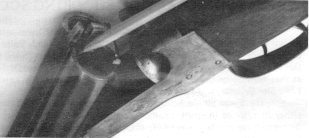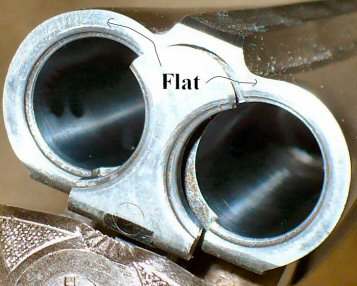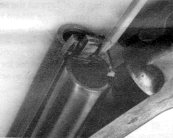UNDERSTANDING THE SHOTGUN
Shooting the Cowboy Double, part 2 of 3
WHERE DOES YOUR SHOTGUN SHOOT? Unless you know already, you should find out where the shot pattern is going relative to your sight picture. Doubles should shoot pretty close to point of aim for both barrels. SOME DON'T! On large pepper popper targets within 15 yards, one misaligned barrel (sight wise) may not be bad enough to keep you from taking the target down. Most of the larger gun shops have shotgun patterning kits for sale. The kits have complete instructions and, if followed, will tell you where each barrel shoots relative to point of aim and how much shot is in the pattern.
SHOTGUN CHOKES ARE IMPORTANT: The chokes on the double barreled shotgun have a BIG impact on the gun's ability to take down targets. Shotgun chokes run approximately .030 under bore size for full choke, .020 under for modified, and from.010 to.012 under for improved cylinder. Cylinder is, of course, no choke at all. This is what you end up with when you, for instance, shorten a 28 inch barrel with chokes to 18 inches. I do not consider myself an expert on chokes, but I do know what has worked well for me, and I'll share it with you.
With the exception of team events, most shotgun targets that we shoot are no further away than 15 yards. Once in a while a stage will sport targets 20 or more yards down range, but not very often. I own and use three different doubles chokeed as follows:
(1) Modem 18 inch Savage Stevens - cylinder or open bore (no choke). This gun works quite well on small or large targets out to 15 yards. Targets much further out, unless of the large pepper popper type, will not always go over, even when aiming quite deliberately.
(2) 1905 20 inch Stevens that appears to be choked modified and improved cylinder. It does very well on small and large targets out to 17 or 18 yards. With larger shot (#6's) and deliberate aim, you can stretch this another yard or two.
(3) 1920's vintage La Fever with 24 inch barrels that were shortened from around 30 inches by persons unknown. I have been told this gun has a tapered bore whereby the metal starts out quite thick at the junction of the action and the barrels and gradually tapers to what was probably a full choke for each barrel. There still seems to be enough bore constriction after shortening that it is somewhere between improved and modified. It takes down small targets out to 21 yards. So far I have not had a pepper popper it would not take down if I did my part.
So - what barrel length and choke size should you use? Longer barrel lengths usually have the choke to reach way out, BUT THE LONGER BARREL LENGTHS ARE A BIT CLUMSY AND SLOWER TO HANDLE.
In my opinion, a double with 20 to 24 inch improved, or better yet, modified barrels will handle virtually all main match targets. 80 to 90 percent of the time you can make do with a gun having 18 inch cylinder bore barrels, and you can stretch the range 2 or 3 yards by using heavier shot and taking deliberate aim, BUT IT IS TOUGH TO CONSISTENTLY TAKE DOWN SMALL TARGETS QUICKLY MUCH PAST 15 - 16 YARDS with this combination. Screw-in chokes can be added to your cylinder bore gun giving you the means to change chokes to suit your shooting situation. At approximately $85 per barrel, this amounts to almost 85% of the cost of an inexpensive double barreled shotgun. However, if done right, the screw-in chokes will do the job and will still shoot to the point of aim.
Editer's Note: Most of us now use open choked shotguns with 18" to 24" barrels and they work well.THE SHOTGUN SHOULD FIT YOU: A quick and simple check for correct fit is the "length of pull" (the distance from the end of the butt stock to the forward trigger).
This shotgun fits Montana Dan for correct "length of pull". Editor's Note: When you place the gun in firing position, see where your thumb is from your nose. The knuckle of the thumb (of the trigger hand) should be 1 to 2 inches in front of your nose. The old test of putting the but against the arm as shown above doesn't work well for some people, especially those with shorter arms.
A good fit will place the center of the pad of your index finger (trigger finger) on the front trigger comfortably without having to stretch to reach it. If you cannot reach the trigger easily, the stock is too long for you. The stock can be fitted to you by removing a portion of the butt end. If your finger is past the trigger, the stock is too short for you. This can be remedied by adding material at the butt, such as a wooden spacer or a thicker recoil pad. An over-length stock is usually more difficult to handle than one that is too short because it is difficult to shoulder quickly. When too long, the stock tends to hang up on your clothing as it is shouldered. (With rifles, it is harder to cycle properly so you will "short cycle" more often.) An under-length stock shoulders easily, but puts your strong eye much closer to the reference aiming point. For far sighted folks such as I, this can cause sight alignment problems.
TUNING FOR SPEED LOADING: A few things can be done to make the fast chambering of ammunition easier. This tuning can also help improve ejection.
Remove sharp edge at end of barrels with a Dremel tool . Run your finger from inside the chamber out to where the end of the barrels join the action. You will likely feel a very sharp edge on the end of the barrels. This edge catches the soft sides of a plastic shot shell and will actually cut the shell as it is quickly chambered, slowing down the loading process somewhat. Using a Dremel tool and a stone, remove this sharp edge.
One very light pass all the way around the edge will do it. Then with the same Dremel tool and a rubber tip impregnated with polishing compound, polish the reworked area. VERY LITTLE METAL need be removed! Just break the sharp corner and polish it. Since the flat portions maintain the headspacing, do not work with them - just the edges.
Chambers of shotgun can be polished with a "home made" tools using crocus cloth to eliminate friction. Polishing the inside of the chambers will aid in the quick ejection of empties. You can do this yourself by making a tool out of a wooden dowel. With a saw, split the dowel down the center and insert a crocus cloth in the split, wrapping it around the dowel to give enough of a fit to the chamber to start the polishing effort. The dowel should be small enough to fit in the chuck of a power drill so you can "spin it up" inside the chamber.
Inspect extractors for burr and remove any found with a Dremel tool. Look at the extractor for burrs. If you find them, use the Dremel tool to remove them and polish this area as well. Burrs have a detrimental effect on the ejection of empties.
To sort out ejection problems, first make sure that the barrels are pointed straight up when opening the action to eject empties. Try all brass base cases. Look for burrs at the extractor. On an older used gun, it is possible to have a burr where the chamber starts (where the ends of the barrels meet the action). Check all these areas. Polish the chambers. Usually going to the all brass based ammunition or Actives is enough to get the empties to fall out like water. Sometimes more work to the shotgun is needed. I recommend Winchester AAs - I use them for everything.
Editor's Note: the new Remington STS are also excellent as well.Shooting the Cowboy Double, part 2 of 3



